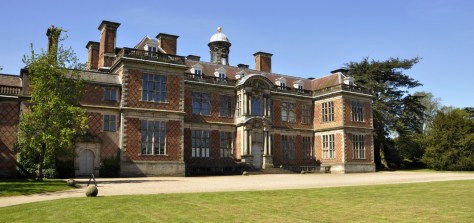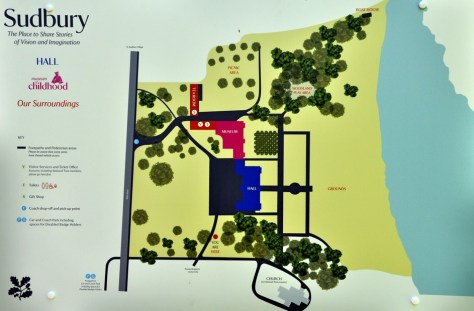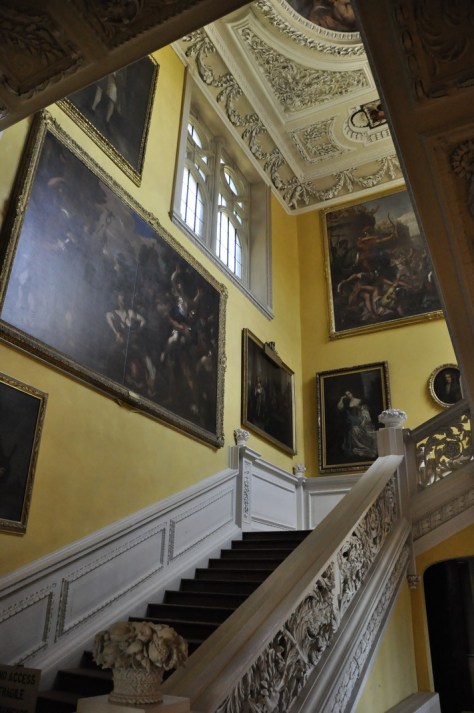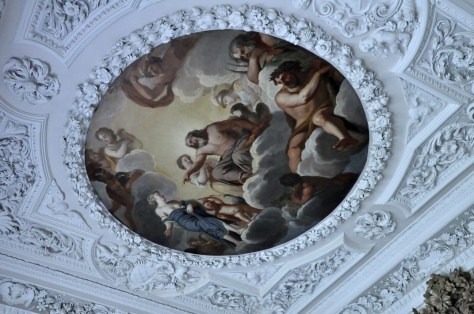What special events occurred 1967? The BBC made its first TV broadcast in colour, and set up BBC Radio 1, 2, 3 and 4; the QE2 ocean liner was launched on the River Clyde; singer Engelbert Humperdinck had several top selling singles of the year; and The Beatles released the iconic album Sgt Pepper’s Lonely Hearts Club Band.
These were just a few highlighted on little signs either side of the footpath from the car park to Sudbury Hall, a National Trust property in Derbyshire, just north of the Staffordshire-Derbyshire boundary, the River Dove (see map).

 But, as we reached the end of the footpath, we encountered the important ‘Sudbury’ fact. Occupied by the same Vernon family since it was built in 1660 by wealthy London merchant George Vernon, Sudbury Hall was bought by the National Trust when the Vernons were forced to relinquish ownership in order to meet death duty liabilities. The Sudbury Vernons were distant cousins of the Vernons of Hanbury Hall (the closest National Trust property to our home in Worcestershire).
But, as we reached the end of the footpath, we encountered the important ‘Sudbury’ fact. Occupied by the same Vernon family since it was built in 1660 by wealthy London merchant George Vernon, Sudbury Hall was bought by the National Trust when the Vernons were forced to relinquish ownership in order to meet death duty liabilities. The Sudbury Vernons were distant cousins of the Vernons of Hanbury Hall (the closest National Trust property to our home in Worcestershire).
Sudbury Hall is a Restoration architectural paradox, idiosyncrasy even: an exterior that harks back to an earlier Jacobean period, disguising sumptuous interiors more typical of the 1660s and early 18th century.
Adjacent to the hall is the Parish Church of All Saints in the Diocese of Derby, with some lovely stained glass windows, and impressive memorials to various generations of Vernons.
The hall is aligned west-east, with the main entrance on the north side. While it has a layout of an earlier building, a large entrance hall, even a long gallery on the first floor facing south, nothing quite prepares you for the flamboyance of the staircase (in the northwest corner), the ceilings and decorations of the saloon and drawing room(s) on the ground floor, and those of the long gallery.
Although George Vernon employed local craftsmen in much of the construction of Hanbury Hall, he did seek out some of the most talented to realise his vision of ‘the good life’.
Much of the plaster ceiling work was carried out by London craftsmen Robert Bradbury and James Pettifer. This is what I found about Bradbury and Pettifer on the website of the Woodcarvers Guild Ltd:
Two London plasterers of this period – the 1660s – whose work was similarly accomplished, were Robert Bradbury and James Pettifer. We know Pettifer trained under the London plasterer Arthur Toogood, who was Master of the Plaisterers [sic] Company in 1663.
Their best work outside London is at Sudbury Hall, Derbyshire, where they plastered ceilings in 1675-6. These are densely and richly decorated wall panelling and oak panelling and deserve close attention. The house was begun for Mary Vernon in the reign of James I, but was far from finished when she died in 1622. It then stood empty as a partly completed shell until after the Restoration, when Mary’s great-grandson, George Vernon, completed it. In doing so, he had the good sense to use excellent carvers, plasterers and painters.
In 1675-6 Bradbury and Pettifer provided the ceilings of the drawing room, the parlour, the staircase hall, the well, the Queen’s Bedroom and that of the 138-ft long gallery. They charged at the rate of 6s a yard and whilst to some eyes their decorations are florid and all-enveloping, the exuberantly fashioned wall panelling and oak panelling ornament was at least confined to the spaces provided in the design. Just enough was allowed to stray beyond the limits set down by the moulded ribs to give a natural effect. In fact, the delicate swirling work, most of it moulded but carefully arranged so that it appeared to consist of many different parts, was positioned with such skill that Laurence Turner wrote in his book on decorative plasterwork in 1927 before the discovery of the accounts, ‘the four well modelled amorini in the corners of the [staircase] cove [are] evidently by an Italian modeller, for no English plasterer could have developed so suddenly the ability to model the human figure …’ In the seven compartments of the long gallery ceiling and its frieze, there are curling flowers and foliage, shells, emperors’ heads, horses galloping from cornucopias, and dragons and wild boar in unlikely proximity to each other. Exquisite wood carving is everywhere.
In the Saloon, family portraits are set in panels carved by Edward Pierce (or Pearce), who also carved the balustrade on the magnificent Great Staircase. The ceiling panel in the saloon and elsewhere are paintings by Louis Laguerre in the Baroque style, which were commissioned by George Vernon a couple of decades later.
The Entrance Hall
Somewhat reminiscent of a medieval hall, Sudbury’s entrance hall has a stone flagstone floor, and stone arched doorways. The walls are covered by several full length portraits. And on three tables are seven exquisite Sèvres porcelain figurines dating to 1860, depicting a boar hunt.
The Great Staircase
Leaving the Entrance Hall, nothing quite prepares you for the magnificence of the staircase, from floor to ceiling, with its intricate carving (apparently in lime wood, and painted white), the paintings on the walls, and the elaborately decorated ceiling. It must rank as one of the most impressive that we have seen in any of our National Trust visits.
The Saloon
An elaborate doorway (mounted with a bust that looks suspiciously like William Shakespeare), you enter the saloon, a room with life-size portraits on all walls, and a smaller painting of the hall’s creator, George Vernon, above the door.
The Long Gallery
This came as a complete surprise. Long galleries were typical of much earlier houses. At Sudbury it extends the whole length of the house and faces south overlooking lawns and the lake. The quality of the plaster work is unparalleled. Currently there is little furniture on display, but at the east end is a beautifully painted 17th century Flemish cabinet with biblical scenes, by Frans Francken II. The frieze around the walls is punctuated by various images, and that on the west wall is apparently of King Charles II. Off the long gallery is a small library, with its own gallery. This opens on to the top of the staircase, and passes right into the Queen’s room.
The Queen’s Room
Over the two doorways are almost identical paintings, almost certainly Dutch, depicting contemporary flowers and fruits. The fireplace is pretty impressive.
Drawing Room(s)
I’ve left the pièce de résistance until last. Leading off the saloon is the drawing room, now divided in two, according to the original 17th century floor plans. It was opened into a single rooms during the 19th century. And why is it the pièce de résistance? Surrounding a full length portrait of a lady is an intricate and quite magnificent wood sculpture, depicting all manner of plants and game animals, carved by renowned Dutch-British sculptor Grinling Gibbons.
This is a special carving. But who was the favored lady? Someone special (nod, nod, wink, wink)? This is indeed a remarkable tribute to someone near and dear. If I remember correctly what one of the volunteers told us, she was the sister-in-law of the wife of George Vernon.
Although the National Trust has owned Sudbury Hall for 50 years (and first opened to the public in 1972), refurbishment of the interior is still a ‘work in progress’. Most of the rooms are still lacking furniture. In this respect, the property reminded me of another National Trust property, Dyrham Park near Bath that we visited in August 2016. Not only had Sudbury Hall to be made safe, but decisions were taken—and still being taken—on how to redecorate each of the rooms. And decisions taken are not to everyone’s approval, as the obituary to the 10th Lord Vernon (referenced earlier) indicates.
 A Museum of Childhood was opened at Sudbury in one of the extensions to the hall. This is a separate entrance to the hall. We enjoyed an interesting 45 minutes viewing all the exhibits bringing back memories of our childhoods, particularly with the various books and toys on display, and also from our daughters from 1978.
A Museum of Childhood was opened at Sudbury in one of the extensions to the hall. This is a separate entrance to the hall. We enjoyed an interesting 45 minutes viewing all the exhibits bringing back memories of our childhoods, particularly with the various books and toys on display, and also from our daughters from 1978.
In the 1950s and early 1960s I used to pass in front of Sudbury Hall from time-to-time, travelling with my parents from our home in Leek to visit my father’s sister who lived just beyond Burton upon Trent. Until the early 1960s, my paternal grandparents lived in the village of Hollington, just a few miles north of Sudbury. This is Jackson-Bull home territory. In those days the main road, much quieter then, passed immediately in front of the hall. Now, the hall and village of Sudbury are fortunately by-passed, but there is nevertheless a continual roar of traffic from nearby and very busy A50 from Derby to Stoke on Trent.
It was a bright and sunny day when we visited Sudbury last week, but with a biting northerly wind. Nevertheless, our visit to Sudbury Hall was a delight, and quite unexpected in terms of what we saw. The volunteers were most helpful and knowledgeable, adding to the enjoyment of our visit. Sudbury Hall is definitely worth a visit if you are in the vicinity—and even if you are not.














































Excellent blog, Mike. While reading it, I felt like am having the great tour myself. Thanks.
LikeLike